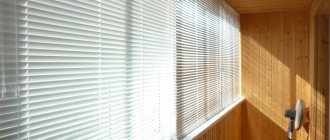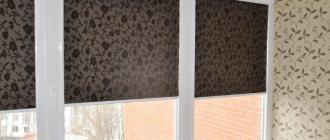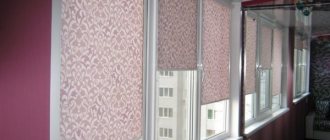Varieties
Today, construction stores offer several types of blinds. Depending on the specific type, the features of fastening curtains change.
Horizontal blinds
You can find several varieties of horizontal blinds on sale. The lamellas in them are installed horizontally, which explains the name of the design. The thickness, width and type of material can be customized. The structure can be attached inside the frame, to the frame itself, to the slope or on top of the window block .
Horizontal blinds are most often installed in institutions
These blinds are installed in offices, production facilities and other places. These designs are universal - if desired, you can find horizontal blinds in almost any color and shade.
Vertical blinds
Due to their design features, such blinds are most often mounted on top of windows . The slats in this case are oriented vertically and are made of plastic or fabric. There are varieties on the market that differ in the length of the slats.
Vertical blinds are mainly installed in residential areas
This model is most often installed in private homes, but they are also in demand in offices. Vertical blinds are installed using self-tapping screws. As an alternative, installation to the ceiling is practiced.
Roller blinds
Roller blinds are made of fabric, completely cover the glass, and if desired, they can be raised by rolling them into a roll. Installation is carried out using brackets, screws or adhesive tape.
Roller blinds can be installed without drilling walls and doors - using double-sided tape
The need for drilling varies depending on the type:
- Vertical structures are mounted on top of the window or under the ceiling. In both cases you will have to drill the surface.
- Horizontal blinds can be attached to the top slope or to the window sashes. Without drilling, such structures can be mounted on the sashes of a window block.
- The interframe analogue, as you can easily guess from the name, is designed for installation inside the window itself. This option requires drilling the largest number of holes.
What to consider during the process
You should pay attention to a common mistake when installing blinds. There is no need to attach horizontal blinds with a solid canvas to the window slopes, as this will make opening the shutters inconvenient.
This method of fastening is not suitable for blinds in the form of a solid canvas.
It is very inconvenient to raise the blinds and then lower them every time you open the shutter (for example, to ventilate the room).
In order for the installed structure to serve for a long time and look attractive, some points must be taken into account during installation:
- when purchasing a design and components, you should pay attention to the fact that all components/parts of the blinds are of high quality (there should be no defects);
- the chain is mounted on the side which is more convenient for it to use;
- When the windows are fully opened, the blinds should fold completely;
- In order for the panels to always look perfect, they must be wiped from time to time with a dry cloth, less often with a damp sponge;
- Maintenance should be carried out in a timely manner.
You can see how horizontal blinds are installed in the video.
Preparation and measurements
To install blinds you will need the following tools:
- screwdriver or screwdriver;
- pencil or marker;
- roulette.
To ensure that all your efforts are not in vain, it is important to carry out the measurements correctly and accurately - only then will the design work effectively. In addition, it must be located absolutely symmetrically to the glass unit. Blinds attached with adhesive tape are more tolerant of errors - they can be corrected if desired. For analogues with self-tapping screws, additional holes will need to be made, which is unlikely to benefit the beauty of the window; flaws here are unacceptable.
At the first stage of installing blinds, measure the width and height of the window
To correctly position the structure relative to the window and floor level, you will need to measure the following parameters:
- window opening dimensions;
- length to the bottom edge of the curtain;
- distance between fasteners.
For horizontal blinds installed on sashes, you will need to additionally measure the dimensions of each glass. To the results obtained, add 2 cm to the top and bottom edges and 0.5 cm to the sides .
Selecting the necessary tool
This type of work will not require you to have a specific professional tool, but the correct selection will greatly simplify the task. It will be easier to do the work, and the result will be much better. So, we need:
- screwdriver (preferably both Phillips and flat);
- a hammer drill or a drill with an impact function (which is better?);
- a set of concrete drills of various diameters and lengths;
- scissors;
- medium sized hammer;
- hacksaw for metal;
- a set of necessary fasteners (usually included with the blinds).
Installation of vertical blinds
Installing vertical blinds is actually not as complicated a process as it might initially seem, and anyone can cope with this task. If the length of the curtain is short, then installation is carried out inside the window opening. Otherwise, the structure is installed under the ceiling or on the wall.
The algorithm of actions here is as follows:
- Marking. The first step is to calculate the center point of the window - it should be on the same level as the center of the cornice. To avoid mistakes, marks should be made along the edges of the structure. Places for screws should be marked on both sides approximately 0.5-0.6 cm closer to the center of the window.
- Rating by level. During the process, it is necessary to ensure that the slats are positioned vertically. The lower part should be 1-2 cm from the floor. A similar distance should be maintained to the window sill if installed directly into the opening.
- Bracket mounting. The holes for the dowels should be prepared in advance, so all that remains is to install them. The bracket is attached using self-tapping screws. Subsequently, complete clips can be installed on these elements for camouflage. When drilling into a wall, you should act very carefully, as otherwise you may break off part of the wall.
Vertical blinds are secured with self-tapping screws to the wall or ceiling
Installation of chain and lamellas. After attaching the cornice, all that remains is to hang the slats, install the runners, and also attach the adjusting chain. An important point: the slats must be hung in the same order in which they are in the box. Otherwise, you can ruin the entire drawing (if there is one) .
Types of brackets
They are divided into ceiling, wall and universal - it depends on the surface to which they are attached. They are usually made of steel or plastic, but are also found in other metals or wood.
By design they are divided into four types.
- Fixed. They are used in cases where rigid installation is necessary.
- Inclined. Such supports change their angle of inclination, which often does not exceed 15 degrees.
- Multi-joint. Made of two parts, they have the ability to change the angle of inclination and rotation.
- Tilt-rotary. Flexible arms that tilt, rotate and change length.
Installation of horizontal blinds
Attaching horizontal blinds to plastic windows is somewhat more complicated. The main thing is to strictly follow the instructions:
- The first step is to secure the upper fasteners. This is done using a screwdriver. First, the holes are prepared, after which the bracket is attached with self-tapping screws.
- We hang the cornice. It should be fastened until it clicks.
- The holes for the lower fasteners are drilled by hand. When choosing a diameter, you should take into account the dimensions of the thread retainer connecting the lamellas. Most often, horizontal blinds require additional holes on the sides. This helps to insert the clamp connected to the lamella fabric into the corners.
When installing horizontal blinds yourself, you must carefully follow the instructions.
Important: self-installation must be done as carefully as possible. Very often the slightest mistake results in the entire structure not functioning correctly.
Roller blinds
In the case of roller blinds, there are several mounting options, so before you start, you should choose the most convenient one. The first is installation on self-tapping screws, which in essence is no different from the option described above, the second is on a special adhesive tape, which is used instead of self-tapping screws, and in the third, the roller blind is hung on the sash.
To fix roller blinds, use brackets or adhesive tape
Important: do not forget about degreasing the plastic - it will help significantly improve the adhesion of materials.
Features of attaching a cornice to a niche in a plasterboard structure
This option for creating an interior, when the cornice of the blinds is hidden deep into the plasterboard structure, is finding more and more fans, because in this case the interior seems more festive and elegant, the eye is not distracted by additional elements, such as the cornice, places where the slats are attached, and the line of the ceiling space immediately rests into the louvered covering.
The cornice is hidden by a plasterboard structure
The installation method in this case is no different, except that you will have to work more carefully and use a longer tool, because drywall can be removed from the surface of the concrete floor at a distance of up to 10 cm.
Inter-frame curtains
Inter-frame curtains are used only for double frames. Installation of blinds of this type is somewhat more complicated than the previous ones, and the process itself will result in an inevitable violation of the integrity of the profile: you will have to drill at least two holes through which the handle and cord to control the system will be cut out.
The curtains themselves are mounted in the inner sash, or more precisely, in its upper part, and the bracket is mounted directly to the upper profile. Installing the structure is in many ways similar to working with horizontal blinds.
Inter-frame curtains are installed in double glazing
Do-it-yourself installation of the system is carried out according to the following algorithm:
- The window frame unwinds and the blinds are applied to the inner sash. This is used to check the size matches.
- Markings are made for fastening, as well as points for the cord and control handle, after which holes with a diameter of about 5 mm are drilled.
- The brackets are inserted into the calipers, the cords and control handles are brought out, with the cord through the lower hole.
- Inter-frame blinds are mounted on the sash with special inter-frame brackets.
- An adapter is installed on the frame, and a control handle is connected to the flexible terminal.
- The control handle and cord lock is installed.
- The frame twists back.
The blinds control element is brought out through the frame.
As you can see, the technology for installing blinds on plastic windows without drilling is completely unsuitable here. The principle itself is similar to the installation of all other design options, with the only difference being that you have to disassemble the frame, screw the bracket into the interframe space, and remove the controls through the drilled holes.
Dismantling
No matter how securely the blinds are attached, there comes a time when they need to be removed in order, for example, to clean them from dirt or repair them.
The process of removing vertical curtains:
- Open and then collect the strips.
- The weights are released.
- Separate the panels from each other.
The process of removing horizontal models:
- Free the cornice from the brackets.
- Remove the decorative panel (if there is one).
- Raise the panel and look for the protrusions of the fasteners.
- The clamps are pulled towards you. Then they are pulled to the right.
- The curtain is pulled down.
- The structure is removed.
The process of removing roller blinds:
- The tongue, which is on the bracket, is bent. To do this, use a screwdriver.
- Remove the shaft.
Blinds that have become obsolete can be removed as easily as they are installed
Useful tips
In order for blinds to serve for many years, you should follow some operating rules:
- When purchasing, you should carefully check the package and all equipment, especially fasteners. They must be of high quality.
- You should choose the adjustment mechanism wisely - it should be on the side that is convenient for use.
- Make sure that no one opens the windows while the blinds are not yet fully closed.
- The rotary handle must not interfere with or touch other fittings.
- Don't forget about periodic maintenance.
- It is quite possible to install blinds on windows yourself, but it is better to entrust its repair to a professional.
- Plastic structures are preferable: they are much easier to care for.
- You should not clean the system too often, this will only lead to rapid wear of the protective layer.
Installing the device yourself, as you can see, is not a difficult task at all, be it metal, plastic or wooden blinds on plastic windows. The main thing is to have quality instructions at hand. Thanks to this material, you can hang your blinds as quickly and efficiently as possible.
Operating rules
Vertical blinds must be properly maintained.
Usually this is dry cleaning; heavily soiled areas can be wiped with a damp rag or sponge; a simple soap solution is used for this. For fabric blinds, wet cleaning is used. The curtain is soaked in soapy water; you cannot rub the surface of the slats; they just need to be rinsed after a certain time (depending on the type of detergent).
Movement diagram of vertical blinds.
What is required to clean blinds? Procedure:
- The bottom chain is removed to free the slats. The weights that hold the strips in a certain position are carefully removed. The slats are lowered into soapy warm water. Gently wipe the mechanism and chains with a damp sponge. All dirt should come off the slats, then they should be rinsed and taken out to dry. Next, the curtain is reassembled.
When cleaning blinds yourself, do not use bleach.
It is forbidden to wash the lamellas or use hard brushes.
It is important not to bend the strips; after rinsing, they are removed from the water and hung in place when wet. If the fabric is wet, then you need to carefully iron the strips through the layer of fabric.
Fiberglass slats can be cleaned with a washing machine or a regular vacuum cleaner. Metal and plastic curtains should be cleaned with a damp or dry sponge and wiped regularly. Wooden blinds are wiped down a couple of times a week.











